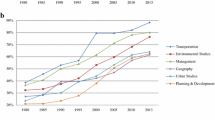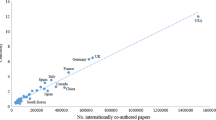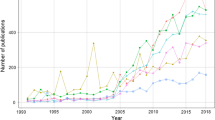Abstract
This paper examined the coauthorship patterns of China’s humanities and social sciences (HSS), based on articles and reviews covered by the Social Science Citation Index and the Arts and Humanities Citation Index of the Web of Science. We defined four types of coauthorship as: no collaboration (NOC), national collaboration (NAC), bilateral international collaboration (BIC) and multilateral international collaboration (MIC), and proposed the development phases of China’s HSS as: 1978–1991, 1992–2000 and 2001–present. Accordingly, we explored the evolution of coauthorship patterns by a number of metrics. Findings include: (1) the coauthorship patterns of China’s HSS significantly evolved from NOC to NAC, BIC and MIC; (2) China’s major collaborators had not significantly varied over the past decade, in which USA had always taken the lead (among every four HSS articles of China, one was collaborated with USA); (3) pic (percentage of internationally coauthored articles) was negatively correlated to pnc (percentage of not cited articles); (4) MIC is 1.5 times the CPP (citation per publication) of BIC, 3 times of NAC and 4 times of NOC. Chinese government has been eagerly promoting economic development through science and technology. However, after over 30 years’ growth miracle, Chinese government realized that China’s HSS had been overshadowed, and then initiated prosperity plannings.



Similar content being viewed by others
References
Ajiferuke, I., Burrel, Q., & Tague, J. (1988). Collaborative coefficient: A single measure of the degree of collaboration in research. Scientometrics, 14(5–6), 421–433.
Avkiran, N. K. (2013). An empirical investigation of the influence of collaboration in Finance on article impact. Scientometrics, 95(3), 911–925.
Basu, A., & Aggarwal, R. (2001). International collaboration in science in India and its impact on institutional performance. Scientometrics, 52(3), 379–394.
Basu, A., & Vinu Kumar, B. S. (2000). International collaboration in Indian scientific papers. Scientometrics, 48(3), 381–402.
Chan, K. S., Xu, X., & Gao, Y. (2014). The China growth miracle: The role of the formal and the informal institutions. World Economy,. doi:10.1111/twec.12193.
Cheng, M. Y., Hen, K. W., Tan, H. P., & Fox, K. F. (2013). Patterns of coauthorship and research collaboration in Malaysia. Aslib Proceedings, 65(6), 659–674.
de Lange, C., & Glänzel, W. (1997). Modelling and measuring multilateral coauthorship in international scientific collaboration. Part I. Development of a new model using a series expansion approach. Scientometrics, 49(3), 593–604.
Deng, Z. L., & Huang, L. (2009). Philosophy and social sciences in China: Towards the world. International Communications, 0(1), 59–61. (in Chinese).
Division of Social Sciences of the Ministry of Education. (2005). Report on the development of philosophy and social sciences in Chinese colleges and universities. Beijing: Higher Education Press.
Frame, J. D. (1977). Mainstream research in Latin America and Caribbean. Interciencia, 2(3), 143–148.
Franceschet, M., & Costantini, A. (2010). The effect of scholar collaboration on impact and quality of academic papers. Journal of Informetrics, 4(4), 540–553.
Fu, H. Z., Chuang, K. Y., Wang, M. H., & Ho, Y. S. (2011). Characteristics of research in China assessed with Essential Science Indicators. Scientometrics, 88(3), 841–862.
Garg, K. C., & Padhi, P. (2001). A study of collaboration in laser science and technology. Scientometrics, 51(2), 415–427.
Gazni, A., Sugimoto, C. R., & Didegah, F. (2012). Mapping world scientific collaboration: Authors, institutions, and countries. Journal of the American Society for Information Science and Technology, 63(2), 323–335.
Gazni, A., & Thelwall, M. (2014). The long-term influence of collaboration on citation patterns. Research Evaluation, 23(3), 261–271.
Glänzel, W., & de Lange, C. (1997). Modelling and measuring multilateral coauthorship in international scientific collaboration. Part II. A Comparative study on the extent and change of international scientific collaboration links. Scientometrics, 49(3), 605–626.
Glänzel, W., Debackere, K., & Meyer, M. (2008). ‘Triad’ or ‘Tetrad’? On global changes in a dynamic world. Scientometrics, 74(1), 59–76.
Glänzel, W., & Schlemmer, B. (2007). National research profiles in the changing Europe (1983–2003). An exploratory study on sectoral characteristics in the Triple Helix. Scientometrics, 70(2), 267–275.
Glänzel, W., & Schubert, A. (2004). Analyzing scientific networks through coauthorship. In H. F. M. Moed, W. Glänzel, & U. Schmoch (Eds.), Handbook of quantitative science and technology research (pp. 257–276). The Netherlands: Kluwer Academic Publishers.
Glänzel, W., & Winterhager, M. (1992). International collaboration of three east European countries with Germany in the sciences, 1980–1989. Scientometrics, 25(2), 219–227.
Gorraiz, J., Reimann, R., & Gumpenberger, C. (2012). Key factors and considerations in the assessment of international collaboration: A case study for Austria and six countries. Scientometrics, 91(2), 417–433.
Guo, M. R. (1978, April 1). The Spring of Science. People’s Daily, p. D3.
He, T. (2009). International scientific collaboration of China with the G7 countries. Scientometrics, 80(3), 571–582.
Huang, C., Su, J., Xie, X., & Li, J. (2014). Basic research is overshadowed by applied research in China: a policy Perspective. Scientometrics, 99(3), 689–694.
Kretschmer, H. (1999). A new model of scientific collaboration. Part 1. Theoretical approach. Scientometrics, 46(3), 501–518.
Kundra, R., & Kretschmer, H. (1999). A new model of scientific collaboration. Part 2. Collaboration patterns of Indian medicine. Scientometrics, 46(3), 519–528.
Leydesdorff, L., & Sun, Y. (2009). National and international dimensions of the triple helix in Japan: University-industry-government versus international coauthorship relations. Journal of the American Society for Information Science and Technology, 60(4), 778–788.
Li, J., Sanderson, M., Willett, P., Norris, M., & Oppenheim, C. (2010). Ranking of library and information science researchers: Comparison of data sources for correlating citation data, and expert judgments. Journal of Informetrics, 4(4), 554–563.
Li, J., & Willett, P. (2010). Bibliometric analysis of Chinese research on cyclization, MALDI-TOF, and antibiotics. Journal of Chemical Information and Modeling, 50(1), 22–29.
Library of Congress. (2014). Library of congress classification outline. 23 July, 2014. http://www.loc.gov/catdir/cpso/lcco/
Lv, H. Y., & Feng, Y. Q. (2009). A measure of authors’ centrality in coauthorship networks based on the distribution of collaborative relationships. Scientometrics, 81(2), 499–511.
Ma, R. (2012). Author bibliographic coupling analysis: A test based on a Chinese academic database. Journal of Informetrics, 6(4), 532–542.
Mattsson, P., Laget, P., Vindefjärd, A. N., & Sundberg, C. J. (2010). What do European research collaboration networks in life sciences look like? Research Evaluation, 19(5), 373–384.
Megnigbeto, E. (2013). International collaboration in scientific publishing: The case of West Africa (2001–2010). Scientometrics, 96(3), 1113–1139.
Meho, L., & Yang, K. (2007). Impact of data sources on citation counts and rankings of LIS faculty: Web of Science versus Scopus and Google Scholar. Journal of the American Society for Information Science and Technology, 58(13), 2105–2125.
Nagpaul, P. S. (1999). Transnational linkages of Indian Science: A structural analysis. Scientometrics, 46(1), 109–140.
Newman, M. E. J. (2001a). Scientific collaboration networks. II. Shortest paths, weighted networks, and centrality. Physical Review E, 64(1), 016132.
Newman, M. E. J. (2001b). The structure of scientific collaboration networks. PNAS, 98(2), 404–409.
Newman, M. E. J. (2004). Coauthorship networks and patterns of scientific collaboration. PNAS, 101(1), 5200–5205.
Niu, F., & Qiu, J. (2014). Network structure, distribution and the growth of Chinese international research collaboration. Scientometrics, 98(2), 1221–1233.
OECD. (2014). Main Science and Technology Indicators. OECD Science, Technology and R&D Statistics (database). doi:10.1787/data-00182-en
Okubo, Y., Dore, J. C., Ojasoo, T., & Miquel, J. F. (1998). A multivariate analysis of publication trends in the 1980s with special reference to south-east Asia. Scientometrics, 41(3), 273–289.
Plotnikova, T., & Rake, B. (2014). Collaboration in pharmaceutical research: Exploration of country-level determinants. Scientometrics, 98(2), 1173–1202.
Schubert, A., & Braun, T. (1986). Relative indicators and relational charts for comparative assessment of publication output and citation impact. Scientometrics, 9(5–6), 281–291.
Schubert, A., & Braun, T. (1990). International collaboration in the sciences, 1981–1985. Scientometrics, 19(1–2), 3–10.
Shrivats, S. V., & Bhattacharya, S. (2014). Forecasting the trend of international scientific collaboration. Scientometrics,. doi:10.1007/s11192-014-1364-x.
Sonnenwald, D. H. (2007). Scientific collaboration. Annual Review of Information Science and Technology, 41(1), 643–681.
Sooryamoorthy, R. (2013). Scientific research in the natural sciences in South Africa: A scientometric study. South African Journal of Science, 109(7–8), 1–11.
Su, X., Deng, S., & Shen, S. (2014). The design and application value of the Chinese Social Science Citation Index. Scientometrics, 98(3), 1567–1582.
Su, X., Han, X. M., & Han, X. N. (2001). Developing the Chinese Social Science Citation Index. Online Information Review, 25(6), 365–369.
Tang, L., & Shapira, P. (2011). China-US scientific collaboration in nanotechnology: Patterns and dynamics. Scientometrics, 88(1), 1–16.
Teodorescu, D., & Andrei, T. (2011). The growth of international collaboration in East European scholarly communities: A bibliometric analysis of journal articles published between 1989 and 2009. Scientometrics, 89(2), 711–722.
Uzun, A. (1996). A bibliometric analysis of physics publications from Middle Eastern countries. Scientometrics, 36(2), 259–269.
van Raan, A. F. J. (1998). The Influence of International Collaboration on the Impact of Research Results, Some simple mathematical considerations concerning the role of self-citations. Scientometrics, 42(3), 423–428.
Yan, E., & Guns, R. (2014). Predicting and recommending collaborations: An author-, institution-, and country-level analysis. Journal of Informetrics, 8(2), 295–309.
Yang, S., Qiu, J., & Xiong, Z. (2010). An empirical study on the utilization of web academic resources in humanities and social sciences based on web citations. Scientometrics, 84(1), 1–19.
Zhang, G., Liu, L., Feng, Y., Shao, Z., & Li, Y. (2014). Cext-N index: A network node centrality measure for collaborative relationship distribution. Scientometrics,. doi:10.1007/s11192-014-1358-8.
Zhang, J., Su, X., & Deng, S. (2008). The academic impact of Chinese humanities and social science research. Aslib Proceedings: New Information Perspectives, 60(1), 55–74.
Zhou, P., & Leydesdorff, L. (2006). The emergence of China as a leading nation in science. Research Policy, 35(1), 83–104.
Zhou, P., Thijs, B., & Glänzel, W. (2009). Is China also becoming a giant in social sciences? Scientometrics, 79(3), 593–621.
Zhou, P., Zhong, Y. F., & Yu, M. G. (2013). A bibliometric investigation on China-UK collaboration in food and agriculture. Scientometrics, 97(2), 267–285.
Acknowledgments
We gratefully acknowledge financial support from the National Natural Science Foundation of China (71203193). We also thank Ms. Alice M. Tan and Dr. Star X. Zhao for data collection, and anonymous reviewers for helpful comments.
Author information
Authors and Affiliations
Corresponding author
Rights and permissions
About this article
Cite this article
Li, J., Li, Y. Patterns and evolution of coauthorship in China’s humanities and social sciences. Scientometrics 102, 1997–2010 (2015). https://doi.org/10.1007/s11192-014-1471-8
Received:
Published:
Issue Date:
DOI: https://doi.org/10.1007/s11192-014-1471-8




